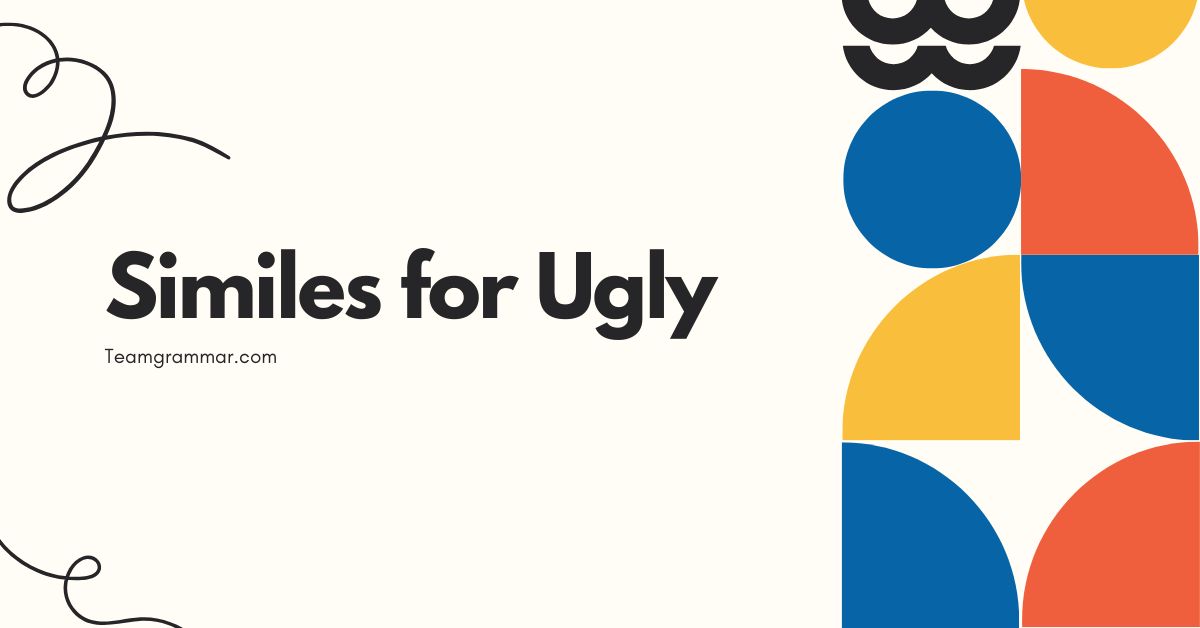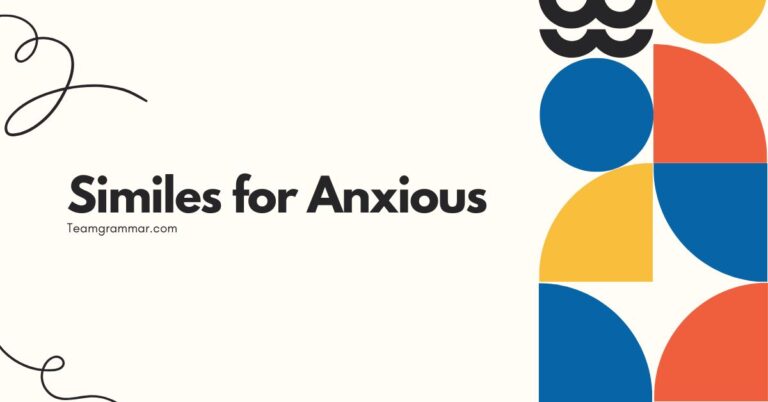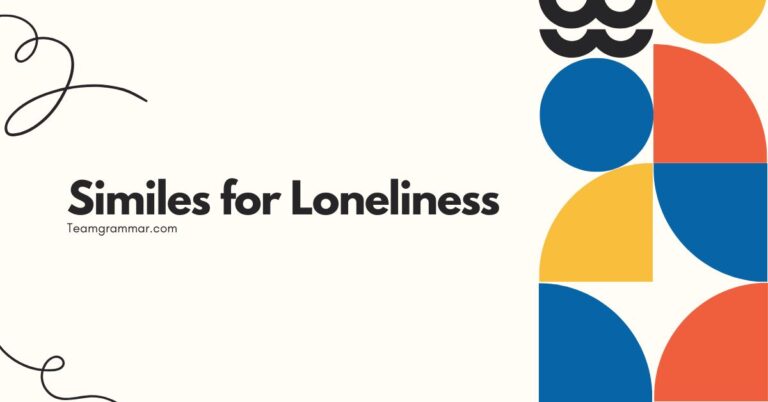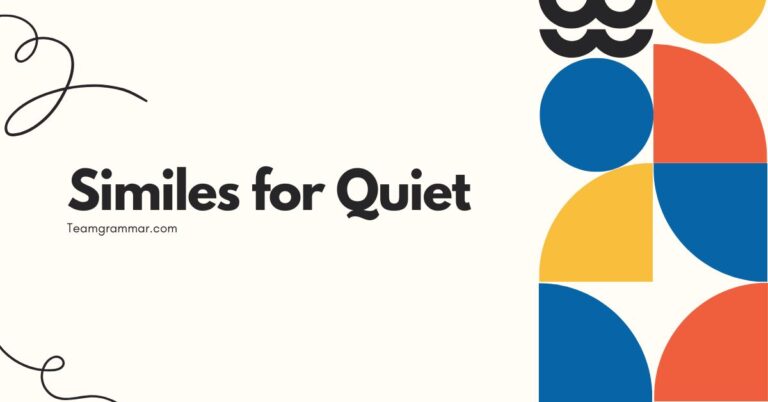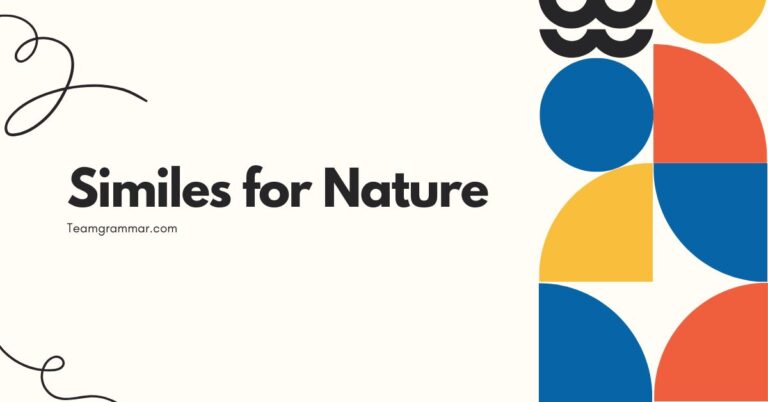43 Similes for Ugly: Mastering Figurative Language in Descriptions
Understanding similes is crucial for enhancing descriptive writing. Similes, a type of figurative language, allow us to create vivid and impactful comparisons, adding depth and color to our communication.
When describing something as “ugly,” similes can be particularly effective in conveying the degree and nature of its unattractiveness. This article is designed for English language learners, writers, and anyone looking to expand their vocabulary and descriptive skills.
By exploring various similes for “ugly,” we will delve into the nuances of comparison and learn how to use them effectively in different contexts.
Whether you’re aiming to improve your creative writing, craft more engaging narratives, or simply enrich your everyday conversations, mastering similes will undoubtedly elevate your language proficiency. This guide provides a comprehensive overview of similes for “ugly,” complete with examples, usage rules, common mistakes, and practice exercises, ensuring a thorough understanding and practical application of this essential literary device.
Table of Contents
- Definition of Simile
- Structural Breakdown of Similes
- Types of Similes for Ugly
- Examples of Similes for Ugly
- Usage Rules for Similes
- Common Mistakes with Similes
- Practice Exercises
- Advanced Topics in Similes
- Frequently Asked Questions
- Conclusion
Definition of Simile
A simile is a figure of speech that directly compares two different things, explicitly using the words “like” or “as.” The purpose of a simile is to illuminate a characteristic of one thing by associating it with something else that is commonly understood to possess that characteristic. Similes add vividness, clarity, and emotional impact to writing and speech.
Similes are essential tools in descriptive writing, allowing authors to create mental images for the reader. By drawing comparisons to familiar objects or concepts, similes can make abstract ideas concrete and enhance the reader’s understanding and engagement.
They are frequently used in literature, poetry, and everyday conversation to make language more expressive and memorable.
The key components of a simile are thesubject(the thing being described), thelinking word(“like” or “as”), and theobject of comparison(the thing it is being compared to). Understanding these components is crucial for both identifying and creating effective similes.
For example, in the simile “as ugly as a troll,” the subject is whatever is being described as ugly, the linking word is “as,” and the object of comparison is “a troll.”
Structural Breakdown of Similes
The basic structure of a simile is quite straightforward, revolving around the explicit comparison of two dissimilar things using “like” or “as.” However, understanding the nuances of this structure can significantly enhance the effectiveness of your similes.
Core Components
- Subject: The entity or concept being described. This is what you want to convey a particular quality about.
- Linking Word: Either “like” or “as.” These words are the glue that binds the subject to the object of comparison.
- Object of Comparison: The entity or concept to which the subject is being compared. This should be something that readily evokes the quality you’re trying to describe.
Variations in Structure
While the core components remain constant, the arrangement and complexity of similes can vary. For instance, you might use a simple simile like “ugly as sin” or a more elaborate one that includes additional descriptive details.
Simple Similes: These are typically short and direct, such as “as ugly as a mud fence.”
Elaborate Similes: These include additional descriptive elements to enhance the comparison. For example, “Her face was as ugly as a gargoyle perched atop a crumbling cathedral, weathered by centuries of storms.”
Implied Similes
Although less common, implied similes suggest a comparison without explicitly using “like” or “as.” These often require the reader to infer the connection between the two things being compared.
Example: “The monster’s visage, a grotesque parody of humanity, repulsed all who beheld it.” (Here, the comparison to a “parody of humanity” implies ugliness without using “like” or “as.”)
Types of Similes for Ugly
Similes for “ugly” can be categorized based on the type of imagery they evoke. Understanding these categories can help you choose the most appropriate simile for a given context.
Animalistic Similes
These similes compare the subject to animals known for their perceived ugliness or unpleasant appearance. Examples include “as ugly as a toad” or “as ugly as a warthog.” These similes often rely on common stereotypes about certain animals.
Object-Based Similes
These similes compare the subject to inanimate objects considered unattractive or undesirable. Examples include “as ugly as a broken mirror” or “as ugly as a rusted nail.” These similes often focus on the physical appearance of the object.
Abstract Similes
These similes compare the subject to abstract concepts or unpleasant experiences. Examples include “as ugly as sin” or “as ugly as a nightmare.” These similes often evoke a sense of disgust or revulsion.
Deformity-Based Similes
These similes compare the subject to something that is deformed or disfigured. Examples include “as ugly as a mangled tree” or “as ugly as a scar.” These similes highlight the imperfection and distortion of the subject’s appearance.
Humorous Similes
These similes use humor to describe ugliness in a lighthearted or satirical manner. Examples include “as ugly as a hat full of hammers” or “as ugly as a skunk at a garden party.” These similes often soften the harshness of the description with a touch of wit.
Examples of Similes for Ugly
Here are several tables providing extensive examples of similes for “ugly,” categorized by the type of imagery they evoke. Each table includes a variety of similes to illustrate the breadth and depth of descriptive possibilities.
Animalistic Similes Examples
This table lists similes that compare ugliness to various animals, often drawing on commonly held perceptions of unattractiveness.
| Simile | Example Sentence |
|---|---|
| As ugly as a toad | The old boot was as ugly as a toad, covered in mud and grime. |
| As ugly as a warthog | His smile was as ugly as a warthog’s tusk, crooked and yellow. |
| As ugly as a vulture | The abandoned building looked as ugly as a vulture, perched ominously on the hill. |
| As ugly as a blobfish | The sculpture was as ugly as a blobfish, a misshapen mass of clay. |
| As ugly as a bat | The old house appeared as ugly as a bat clinging to a cave wall, dark and unwelcoming. |
| As ugly as a hagfish | The discarded tire looked as ugly as a hagfish, slimy and repulsive. |
| As ugly as a naked mole rat | The overgrown lawn was as ugly as a naked mole rat, patchy and bare. |
| As ugly as a spider | The graffiti on the wall was as ugly as a spider crawling across a canvas, messy and unwelcome. |
| As ugly as a pig’s snout | The dented car was as ugly as a pig’s snout, bulbous and unattractive. |
| As ugly as a worm | The rotting fruit was as ugly as a worm, writhing and decaying. |
| As ugly as a snail | The old, peeling wallpaper was as ugly as a snail trail, slimy and unsightly. |
| As ugly as a cockroach | The stain on the carpet was as ugly as a cockroach, stubbornly refusing to disappear. |
| As ugly as a slug | The mold growing in the corner was as ugly as a slug, slow and repulsive. |
| As ugly as a rat’s tail | Her unkempt hair was as ugly as a rat’s tail, thin and greasy. |
| As ugly as a plucked chicken | The barren field looked as ugly as a plucked chicken, empty and desolate. |
| As ugly as a festering wound (animalistic in implication) | The political corruption was as ugly as a festering wound, poisoning the entire system. |
| As ugly as a snapping turtle | His personality was as ugly as a snapping turtle, aggressive and unappealing. |
| As ugly as a mangy dog | The neglected garden was as ugly as a mangy dog, overgrown and uncared for. |
| As ugly as a crow’s nest | The tangled wires looked as ugly as a crow’s nest, a chaotic mess. |
| As ugly as a buzzard | The abandoned car was as ugly as a buzzard, waiting to scavenge what it could. |
Object-Based Similes Examples
This table provides similes that compare ugliness to inanimate objects, focusing on their undesirable qualities or appearances.
| Simile | Example Sentence |
|---|---|
| As ugly as a broken mirror | The shattered vase was as ugly as a broken mirror, reflecting only fragments of its former beauty. |
| As ugly as a rusted nail | The old gate was as ugly as a rusted nail, corroded and forgotten. |
| As ugly as a cracked vase | Her smile was as ugly as a cracked vase, fragile and flawed. |
| As ugly as a torn curtain | The dilapidated building was as ugly as a torn curtain, revealing its decay to the world. |
| As ugly as a stained rug | The memory was as ugly as a stained rug, forever marring the room of her mind. |
| As ugly as a dented can | The presentation was as ugly as a dented can, squashed and unappealing. |
| As ugly as a burnt pot | The relationship was as ugly as a burnt pot, scorched and unusable. |
| As ugly as a discarded tire | The neighborhood was as ugly as a discarded tire, neglected and unwanted. |
| As ugly as a broken toy | His dreams were as ugly as a broken toy, shattered and irreparable. |
| As ugly as a faded photograph | The truth was as ugly as a faded photograph, distorted and unclear. |
| As ugly as a tangled wire | The situation was as ugly as a tangled wire, confusing and difficult to resolve. |
| As ugly as a leaky faucet | The problem was as ugly as a leaky faucet, annoying and persistent. |
| As ugly as a chipped plate | Her manners were as ugly as a chipped plate, rough and unrefined. |
| As ugly as a dusty book | His knowledge was as ugly as a dusty book, outdated and irrelevant. |
| As ugly as a peeling wallpaper | The secret was as ugly as a peeling wallpaper, revealing the cracks beneath. |
| As ugly as a broken window | His soul was as ugly as a broken window, letting in only cold and despair. |
| As ugly as a rusty pipe | The city’s infrastructure was as ugly as a rusty pipe, decaying and unreliable. |
| As ugly as a cracked pavement | The street was as ugly as a cracked pavement, uneven and dangerous. |
| As ugly as a tattered flag | The nation’s reputation was as ugly as a tattered flag, dishonored and disgraced. |
| As ugly as a discarded wrapper | The empty promise was as ugly as a discarded wrapper, meaningless and wasteful. |
Abstract Similes Examples
This table presents similes comparing ugliness to abstract concepts or unpleasant experiences, often evoking strong emotions.
| Simile | Example Sentence |
|---|---|
| As ugly as sin | The lie was as ugly as sin, a dark stain on his conscience. |
| As ugly as a nightmare | The memory was as ugly as a nightmare, haunting her dreams. |
| As ugly as betrayal | The act of treachery was as ugly as betrayal, a deep wound that would never fully heal. |
| As ugly as despair | His outlook on life was as ugly as despair, filled with hopelessness and gloom. |
| As ugly as a broken promise | The politician’s actions were as ugly as a broken promise, shattering public trust. |
| As ugly as a festering secret | The truth hidden beneath the surface was as ugly as a festering secret, slowly poisoning everything. |
| As ugly as regret | The decision haunted him, as ugly as regret clinging to his soul. |
| As ugly as a bitter truth | The reality of the situation was as ugly as a bitter truth, hard to swallow and accept. |
| As ugly as a vacant stare | His expression was as ugly as a vacant stare, devoid of emotion and understanding. |
| As ugly as a hollow victory | The win felt as ugly as a hollow victory, achieved at too great a cost. |
| As ugly as a silent scream | Her suffering was as ugly as a silent scream, unseen and unheard. |
| As ugly as a haunting memory | The past was as ugly as a haunting memory, forever lingering in her mind. |
| As ugly as a broken heart | Her grief was as ugly as a broken heart, shattered and irreparable. |
| As ugly as a lost cause | The fight seemed as ugly as a lost cause, destined to fail. |
| As ugly as a fading hope | Their chances of success were as ugly as a fading hope, dwindling with each passing day. |
| As ugly as a wasted opportunity | His inaction was as ugly as a wasted opportunity, a chance forever lost. |
| As ugly as a broken dream | Her ambitions were as ugly as a broken dream, shattered and unattainable. |
| As ugly as a painful silence | The awkwardness in the room was as ugly as a painful silence, heavy and unbearable. |
| As ugly as a lingering doubt | His uncertainty was as ugly as a lingering doubt, undermining his confidence. |
| As ugly as an unfulfilled potential | His life was as ugly as an unfulfilled potential, a wasted gift. |
Deformity-Based Similes Examples
This table includes similes that compare ugliness to something deformed or disfigured, emphasizing imperfection and distortion.
| Simile | Example Sentence |
|---|---|
| As ugly as a mangled tree | The car wreck was as ugly as a mangled tree, twisted and broken. |
| As ugly as a scar | The old wound was as ugly as a scar, a permanent reminder of the past. |
| As ugly as a twisted limb | The gnarled branch was as ugly as a twisted limb, contorted and unnatural. |
| As ugly as a birthmark | His resentment was as ugly as a birthmark, a permanent disfigurement of his personality. |
| As ugly as a deformed face | The mask he wore was as ugly as a deformed face, hiding his true self. |
| As ugly as a hunchback | His posture was as ugly as a hunchback, stooped and burdened. |
| As ugly as a missing tooth | Her smile was as ugly as a missing tooth, incomplete and awkward. |
| As ugly as a limp | His confidence was as ugly as a limp, unsteady and faltering. |
| As ugly as a clubfoot | The hastily built structure was as ugly as a clubfoot, awkward and unbalanced. |
| As ugly as a disfigured statue | The vandalized monument was as ugly as a disfigured statue, defaced and ruined. |
| As ugly as a burn victim | The forest after the fire was as ugly as a burn victim, scarred and desolate. |
| As ugly as a tumor | The corruption within the organization was as ugly as a tumor, growing and destructive. |
| As ugly as a keloid | The memory persisted, as ugly as a keloid, raised and sensitive. |
| As ugly as a shriveled fruit | The dried up plant was as ugly as a shriveled fruit, lifeless and undesirable. |
| As ugly as a conjoined twin | The two opposing ideas were as ugly as conjoined twins, inseparable and monstrous. |
| As ugly as a malformed hand | His handwriting was as ugly as a malformed hand, illegible and awkward. |
| As ugly as a webbed foot | The ill-fitting shoe was as ugly as a webbed foot, unnatural and uncomfortable. |
| As ugly as a fused spine | The inflexible policy was as ugly as a fused spine, rigid and unyielding. |
| As ugly as a cleft palate | His speech was as ugly as a cleft palate, distorted and difficult to understand. |
| As ugly as a withered flower | Her hopes were as ugly as a withered flower, dried up and lifeless. |
Usage Rules for Similes
Using similes effectively requires adherence to certain rules to ensure clarity and impact. Here are some key guidelines to follow:
Clarity of Comparison
Ensure that the comparison you are making is clear and easily understood by your audience. The object of comparison should be something familiar or evocative enough to create the desired mental image.
Relevance of Comparison
The quality you are highlighting should be relevant to both the subject and the object of comparison. The connection between the two should be logical and meaningful.
Avoid Clichés
While some similes are widely used, overuse can diminish their impact. Strive for originality and creativity in your comparisons to make your writing more engaging.
Consistency of Tone
The tone of your simile should align with the overall tone of your writing. Avoid using humorous similes in serious contexts, or vice versa.
Appropriate Use of “Like” and “As”
Use “like” to compare nouns or pronouns, and “as” to compare clauses. For example: “He runs like the wind” (nouns) vs.
“He runs as quickly as the wind blows” (clauses).
Common Mistakes with Similes
Even experienced writers can make mistakes when using similes. Here are some common errors to avoid:
Using Metaphors Instead of Similes
A metaphor states that something *is* something else, while a simile compares two things using “like” or “as.” Misusing these terms can confuse the reader.
Incorrect (Metaphor): “The room was a pigsty.”
Correct (Simile): “The room was as ugly as a pigsty.”
Using Unclear Comparisons
If the object of comparison is obscure or unfamiliar, the simile will fail to create the intended image.
Incorrect: “The painting was as ugly as a flibbertigibbet.” (Most people don’t know what a flibbertigibbet is in this context.)
Correct: “The painting was as ugly as a chaotic mess of colors.”
Overusing Similes
Too many similes in a short space can make your writing feel cluttered and distracting. Use them sparingly for maximum impact.
Mixing Metaphors and Similes
Avoid combining metaphors and similes within the same comparison, as this can create confusing and contradictory images.
Incorrect: “His anger was like a volcano, erupting into a sea of rage.” (Combines simile “like a volcano” with metaphor “sea of rage”)
Correct: “His anger was like a volcano erupting.” (Simile)
Correct: “His anger was a volcano of rage.” (Metaphor)
Practice Exercises
Test your understanding of similes with these practice exercises. Choose the best simile to complete each sentence, or create your own.
Exercise 1: Completing Similes
Complete the following sentences by choosing the most appropriate simile from the options provided.
| Question | Options | Answer |
|---|---|---|
| The old car was ____________. | a) as fast as a rocket, b) as ugly as a rusted nail, c) as comfortable as a cloud | b) as ugly as a rusted nail |
| His behavior was ____________. | a) as sweet as honey, b) as ugly as sin, c) as bright as the sun | b) as ugly as sin |
| The abandoned house looked ____________. | a) as inviting as a warm fire, b) as ugly as a vulture, c) as clean as a whistle | b) as ugly as a vulture |
| The painting was ____________. | a) as beautiful as a sunset, b) as ugly as a mangled tree, c) as vibrant as a rainbow | b) as ugly as a mangled tree |
| The food tasted ____________. | a) as delicious as chocolate, b) as ugly as a toad, c) as refreshing as lemonade | b) as ugly as a toad |
| Her attitude was ____________. | a) as cheerful as a lark, b) as ugly as a festering secret, c) as gentle as a lamb | b) as ugly as a festering secret |
| The landscape was ____________. | a) as picturesque as a postcard, b) as ugly as a discarded tire, c) as serene as a lake | b) as ugly as a discarded tire |
| The situation was ____________. | a) as clear as day, b) as ugly as a broken promise, c) as simple as ABC | b) as ugly as a broken promise |
| The sculpture was ____________. | a) as graceful as a swan, b) as ugly as a blobfish, c) as delicate as a flower | b) as ugly as a blobfish |
| The truth was ____________. | a) as pleasant as a dream, b) as ugly as a bitter truth, c) as welcome as a gift | b) as ugly as a bitter truth |
Exercise 2: Creating Your Own Similes
Write your own similes for “ugly” to describe the following scenarios.
- Describe an ugly piece of clothing.
- Describe an ugly building.
- Describe an ugly personality trait.
- Describe an ugly meal.
- Describe an ugly piece of art.
- Describe an ugly garden.
- Describe an ugly sound.
- Describe an ugly feeling.
- Describe an ugly situation.
- Describe an ugly thought.
Possible Answers:
- The dress was as ugly as a clown’s costume.
- The building was as ugly as a concrete bunker.
- His arrogance was as ugly as a festering wound.
- The soup tasted as ugly as dishwater.
- The painting was as ugly as a chaotic mess of colors.
- The garden was as ugly as a neglected junkyard.
- The screech was as ugly as nails on a chalkboard.
- Her jealousy was as ugly as a venomous snake.
- The political climate was as ugly as a battlefield.
- The prejudice was as ugly as a festering sore.
Advanced Topics in Similes
For advanced learners, exploring the nuances of similes can lead to more sophisticated and impactful writing. Here are some advanced topics to consider:
Extended Similes
An extended simile develops the comparison over several sentences or even paragraphs, creating a more detailed and immersive image. This technique is often used in poetry and prose to add depth and complexity to the description.
Subverted Similes
A subverted simile intentionally defies expectations by comparing something to something unexpected or contradictory. This can create a humorous or ironic effect.
Cultural Context of Similes
The effectiveness of a simile can depend on the cultural background of the audience. Understanding cultural references and associations is crucial for crafting similes that resonate with your intended readers.
Frequently Asked Questions
Here are some frequently asked questions about similes to further clarify their usage and understanding.
- What is the difference between a simile and a metaphor?
A simile explicitly compares two things using “like” or “as,” while a metaphor implies a comparison by stating that one thing *is* another. Similes are more direct and less assertive than metaphors. For example, “He is like a lion” (simile) vs. “He is a lion” (metaphor).
- Can a simile be too long?
Yes, a simile can be too long if it becomes convoluted or distracting. The comparison should enhance the description without overshadowing it. Aim for clarity and conciseness, especially in simpler writing.
- How can I avoid using clichés in my similes?
To avoid clichés, try to think of original and unexpected comparisons. Brainstorm different associations with the quality you want to describe and choose the most unique and evocative option. Also, consider using more specific and detailed imagery.
- Is it okay to use similes in formal writing?
Yes, similes can be used in formal writing, but sparingly. They are more common in creative writing and less frequent in academic or technical writing. When used in formal contexts, ensure they are appropriate for the tone and audience.
- How do I choose the right simile for a particular situation?
Consider the context, audience, and the effect you want to create. Choose a simile that is clear, relevant, and consistent with the overall tone of your writing. Think about what images or associations will resonate most with your readers.
- What are some common sources of inspiration for similes?
Common sources of inspiration for similes include nature, animals, everyday objects, emotions, and experiences. Observing the world around you and paying attention to sensory details can spark creative comparisons.
- Can similes be used in spoken language?
Absolutely! Similes are frequently used in spoken language to make descriptions more vivid and engaging. They can add color and personality to conversations and presentations.
- How can I improve my ability to create effective similes?
Practice regularly, read widely, and pay attention to how other writers use similes. Experiment with different comparisons and ask for feedback on your writing. The more you practice, the better you will become at crafting effective similes.
- Are there any cultures where similes are more or less common?
The prevalence of similes can vary across cultures. Some cultures may favor more direct language, while others appreciate figurative expressions. Understanding the cultural context can help you use similes appropriately.
- Can a simile be offensive?
Yes, a simile can be offensive if it relies on stereotypes, prejudices, or insensitive comparisons. Be mindful of the potential impact of your words and avoid using similes that could be harmful or disrespectful.
Conclusion
Mastering similes is an invaluable skill for anyone seeking to enhance their descriptive writing and communication abilities. By understanding the structure, types, and usage rules of similes, you can create vivid and impactful comparisons that engage your audience and bring your words to life.
Remember to practice regularly, avoid clichés, and consider the context and tone of your writing when choosing your similes.
This comprehensive guide has provided you with a wealth of examples, exercises, and insights into the art of crafting effective similes for “ugly.” By applying these principles, you can elevate your writing to new heights, adding depth, color, and emotional resonance to your descriptions. Continue to explore and experiment with similes to discover the endless possibilities they offer for enriching your language.
As you continue your journey in mastering English grammar and figurative language, remember that the key to success lies in consistent practice and a keen eye for detail. Embrace the challenge of crafting original and compelling similes, and you will undoubtedly reap the rewards of more engaging and impactful communication.

